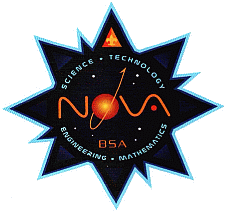This award may be earned by Bear and Wolf Cub
Scouts, and Webelos Scouts (including those earning or having earned the
Arrow of Light).
Lion and Tiger Cub Scouts are not eligible for the Nova Awards.
This is a new Nova award, which was introduced around May 1, 2018.
![]()
This module is designed to help you explore how symmetry affects your life each day.
- Choose A or B or C and complete ALL the requirements.
- Watch an episode or episodes (about one hour total) of a show that
involves symmetry, mirrors, or artistic patterns Then do the following:
- Make a list of at least two questions or ideas from what you watched.
- Discuss two of the questions or ideas with your counselor.
- Read (about one hour total) about anything that involves symmetry,
mirrors, or artistic patterns. Then do the following
- Make a list of at least two questions or ideas from what you read.
- Discuss two of the questions or ideas with your counselor.
- Do a combination of reading and watching (about one hour total)
about anything that involves symmetry, mirrors, or artistic patterns.
Then do the following:
- Make a list of at least two questions or ideas from what you read and watched.
- Discuss two of the questions or ideas with your counselor.
- Watch an episode or episodes (about one hour total) of a show that
involves symmetry, mirrors, or artistic patterns Then do the following:
- Complete ONE adventure from the following list or complete option A
or B. (If you choose an adventure, choose one you have not previously earned.)
Discuss with your counselor what kind of science, technology, engineering,
or math was used in the adventure.
Option A: Complete all of the following:Wolf Cub Scouts Bear Cub Scouts Webelos Scouts Collections and Hobbies Robotics Adventures in Science Germs Alive Super Science Engineering Motor Away Game Design - Explain the difference between the symmetry of the flower of a geranium and the symmetry of the flower of herbaceous periwinkle.
- Explain the difference in leaf arrangement (the pattern of where leaves appear on the stem) between a maple tree and a sweetgum tree.
- Find another pair of plants that you can distinguish based on some difference in symmetry.
- Using toothpicks and colored marsh mallows, or other appropriate materials, make a model of the crystal structure of olivine.
- Using toothpicks and colored marsh mallows, or other appropriate materials, make a model of the crystal structure of halite,
- Use your models to guess which of the two minerals is harder.
- Choose TWO from A or B or C or D or E and complete ALL the requirements
for the options you choose.
- A. Make a paper lantern.
- Fold a large piece of paper in quarters lengthwise.
- Cut decorative or symbolic shapes into the two folded edges.
- Unfold, tape the two edges of the paper together, and smooth into a cylinder. Hang by a string.
- Learn about the kolam artwork of southern India.
- Look at some pictures of kolams. Find as many similarities as possible within each kolam. Is there a repeated pattern? If you turn it a little, do you get the same picture? If you look at it in a mirror, do you get the same picture?
- Use sand, chalk dust, flour, or some other material to make a kolam of your own.
- Learn about the litema wall decorations from Lesotho and South Africa.
- Look at some pictures of litema. What does one basic tile look like? In how many ways can you see that tile arranged (turned a different direction, flipped backward, etc)
- Use clay. paper, or some other material to make a litema of your own.
- Learn about the design of Navajo rugs.
- Look at some pictures of Navajo rugs. Find as many similarities as possible within each rug. Is there a repeated pattern? Is there a mirror image? How many?
- Using different colors of paper, or other materials, make your own Navajo-like rug.
- Learn about Seminole or Miccosukee patchwork designs.
- Look at some pictures of Seminole or Miccosukee patchwork. Find as many similarities as possible within each piece. What does a basic block of each pattern look like? How many different basic blocks are used in the design?
- Using different colors of paper, or other materials, make your own Seminole-like patchwork.
- A. Make a paper lantern.
- Visit a place where symmetry is important (such as an art exhibit, building site, or printer) or visit with a person who works with symmetry (such as an artist, interior designer, or landscape architect). Discuss with your counselor the symmetry or ideas of balance involved.
- 5. Discuss with your counselor how symmetry impacts your everyday life
The requirements for and further information about
this award may be found in the current edition of the
Cub Scout Nova Awards Guidebook (BSA Publication No. 34032) or on
Scouting.org








